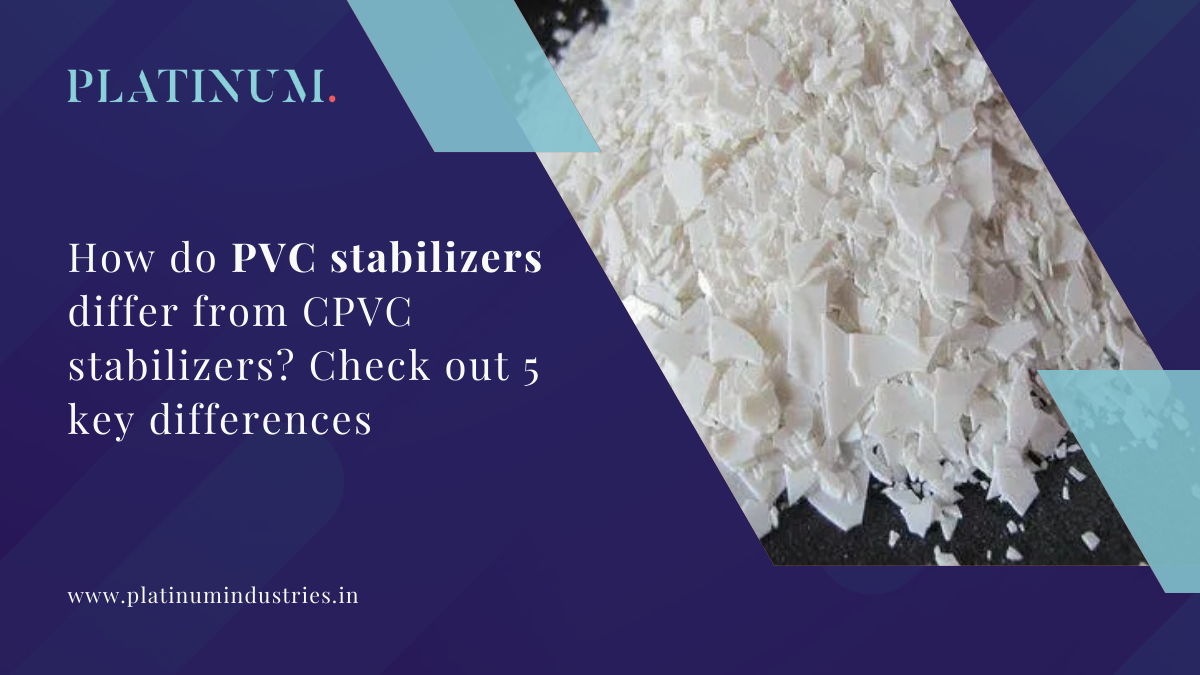Polyvinyl chloride (PVC) and chlorinated polyvinyl chloride (CPVC) are two of the most widely used input materials in the manufacturing and construction industry. They are both thermoplastic polymers, and as suggested by their names, are quite similar in many ways. However, that doesn’t stop them from having key differences in some important avenues, especially the types of stabilizers they require to prevent degradation.
In this blog, we’ll take you through five crucial differentiating points between PVC and CPVC stabilizers, to help you broaden your knowledge base on these important industrial materials:
1. Type of Stabilizers
PVC stabilizers are primarily lead-based, tin-based, or calcium-zinc as well as organic-based, whereas CPVC stabilizers are heavy metal-free, calcium-organic or organic-based but presently people are using Methyl and Butyl tin mostly. The heavy metals used in PVC lead stabilizers have become a concern due to their toxicity and potential environmental harm. CPVC stabilizers, on the other hand, are more sustainable and environmentally friendly, making them the better choice.
2. Manufacturing
PVC stabilizers are typically added during the manufacturing process in the form of PVC superpacks as well as individual stabilizers during compounding, while CPVC stabilizers are added as CPVC addpacks manufactured by a CPVC add packs manufacturer.
The manufacturing process for PVC involves polymerizing vinyl chloride monomer (VCM) into PVC resin, which is then processed into pipes and fittings. The process for manufacturing CPVC is similar, but an additional chlorination step is required to achieve the desired properties. Another difference between the two materials is their colour. PVC is typically white or gray, while CPVC is usually a light yellow colour. Overall, the manufacturing differences between PVC and CPVC are relatively minor, with the primary difference being the chlorination step required to produce CPVC.
3. Chemical Structure
PVC is a polymer made from vinyl chloride monomer, whereas CPVC is a polymer made from chlorinated vinyl chloride polymer through chlorination. The difference in their chemical structure makes them incompatible with some of the stabilizers.
4. Temperature Resistance
CPVC is a more heat-resistant material than PVC, making it more suitable for use in high-temperature applications. This also means that CPVC stabilizers must be more heat-resistant than PVC stabilizers to ensure effective protection.
5. Applications
PVC is commonly used in constructing pipes, windows, and siding, while CPVC is used for hot water pipes, fire sprinkler systems, and industrial applications. The specific applications of these materials require different stabilizers to ensure their performance and longevity.
In conclusion, the choice of stabilizer, be it for PVC or CPVC, depends on the application of the material, the desired level of sustainability, and the inclination towards environmental friendliness. While PVC stabilizers have traditionally been lead-based, tin-based, or calcium-zinc, CPVC stabilizers are heavy metal-free, calcium-organic, or organic-based. This makes their usage perfectly sustainable and environmentally friendly. With climate change upon us, green stabilizers are becoming increasingly important, making CPVC the more attractive choice for many applications. The increasing focus on sustainability and the environment has pushed us towards green alternatives, where CPVC emerges triumphant. In line with this, Platinum Industries. A leading PVC stabilizer manufacturer in India regularly invests a lot in R&D to create sustainable and environment-friendly stabilizers. Connect with us to know more.
ALSO, YOU CAN READ OUR NEW UPDATES
- Quality control of PVC stabilizers – A kind of Magic?
- These are the Days of Our Lives – India Paves the Way for Lead-free Stabilisers
- What are the functions of the cpvc additives? Check out this guide
- Wondering How To Find The Best Lead Stabilizer Manufacturer? Here Are Some Tips That Might Help
- 5 Reasons Why You Should Switch To The Organic-Based Stabilizers
- What is Zinc Stearate? Learn About its Applications Here
- How To Choose Cpvc Additives? Here Are The Tips To Keep In Mind

